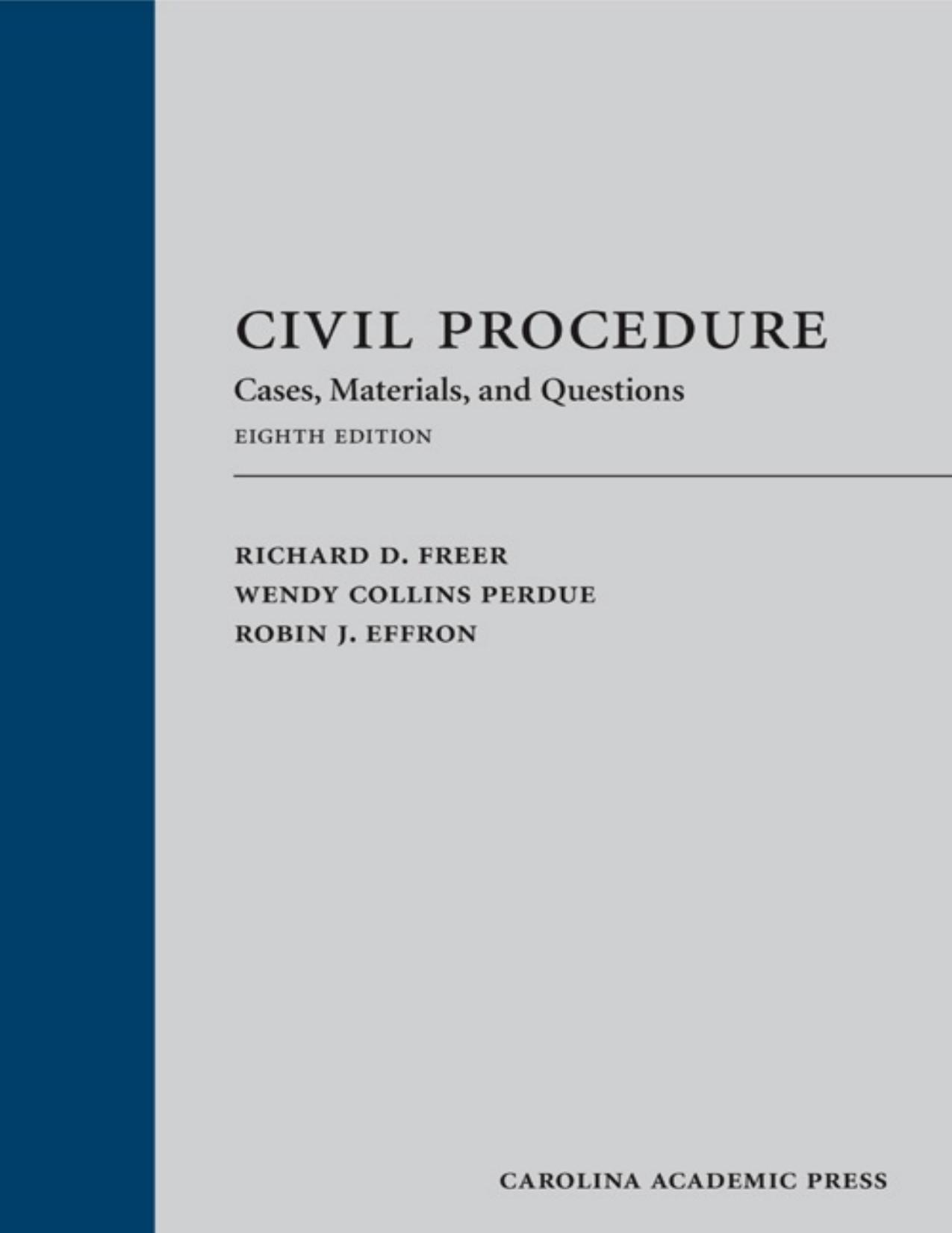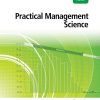Civil Procedure Cases Materials and Questions 8th edition by Richard Freer, Wendy Collins Perdue, Robin Effron ISBN 1531014097 9781531014094
$70.00 Original price was: $70.00.$35.00Current price is: $35.00.
Instant download Civil Procedure Cases Materials and Questions Eighth Edition 8th Richard D. Freer after payment
Civil Procedure Cases Materials and Questions 8th edition by Richard Freer, Wendy Collins Perdue, Robin Effron – Ebook PDF Instant Download/Delivery: 1531014097 , 9781531014094
Full download Civil Procedure Cases Materials and Questions 8th edition after payment

Product details:
ISBN 10: 1531014097
ISBN 13: 9781531014094
Author: Richard Freer, Wendy Collins Perdue, Robin Effron
This innovative casebook is accessible to first-year students and exposes them to the richness of the course. Each chapter begins with an “Introduction and Integration” section, which provides an overview and indicates how the materials relate to other topics. The book features clear original textual explication to set up consideration of cases, and addresses strategic, ethical, and remedial issues encountered in civil litigation. The eighth edition is wholly up-to-date through federal rule amendments of 2020.
Civil Procedure Cases Materials and Questions 8th Table of contents:
Chapter 1 • An Introduction to the Civil Action and Procedure
A. The Study of Procedure
B. Federalism
C. Overview of the Structure of a Court System
1. Trial Courts
2. Intermediate Appellate Courts
3. Supreme Courts
4. Appellate Practice and the Doctrine of Precedent
D. The Adversary System
E. Alternatives to Litigation
F. A Brief History of Our English Judicial Roots
G. General Topics of Civil Procedure
1. Selecting the Forum (Chapters 2–5, 10)
2. Obtaining Provisional Remedies (Chapter 6)
3. Learning About the Opponent’s Case (Chapters 7 & 8)
4. Adjudication With or Without a Jury (Chapter 9)
5. Preclusion, Joinder, and Supplemental Jurisdiction (Chapters 11–13)
6. Appeal (Chapter 14)
7. Litigation Alternatives (Chapter 15)
8. A Quick Note on Materials
Chapter 2 • Personal Jurisdiction
A. Introduction and Integration
B. Constitutional Limits on Personal Jurisdiction
1. The Fountainhead — Pennoyer v. Neff
2. Interim Developments
3. The Modern Era
4. General Jurisdiction
5. Specific Jurisdiction in the Era of Limited General Jurisdiction
6. Personal Jurisdiction and the Internet
7. Explicit Consent and Forum Selection Provisions
8. In Rem and Quasi-in-Rem Jurisdiction
9. Transient Presence (“Tag” Jurisdiction)
C. Statutory Limits on Personal Jurisdiction
D. Challenging Personal Jurisdiction
1. The Traditional and Modern Approaches to Challenging Personal Jurisdiction
2. Collateral and Direct Attacks on Personal Jurisdiction
E. A Different Perspective
1. The Purposes of Personal Jurisdiction
2. Personal Jurisdiction in Other Countries
Chapter 3 • Notice and Opportunity to Be Heard
A. Introduction and Integration
B. Notice
1. The Constitutional Requirement
2. Statutory Requirements
3. Immunity, Evasion, and “Sewer Service”
C. Opportunity to Be Heard
Chapter 4 • Subject Matter Jurisdiction
A. Introduction and Integration
B. State Courts and General Subject Matter Jurisdiction
C. Federal Courts and Limited Subject Matter Jurisdiction
1. The Constitutional Grants and Role of Congress
2. Plaintiff’s Burden to Establish Federal Subject Matter Jurisdiction
3. Diversity of Citizenship and Alienage Jurisdiction
4. Federal Question Jurisdiction
5. Supplemental Jurisdiction
6. Removal Jurisdiction
7. Remand to State Court
D. Challenging Federal Subject Matter Jurisdiction
Chapter 5 • Venue
A. Introduction and Integration
B. Local and Transitory Actions
C. State Venue Provisions
D. Venue in Federal Court
E. Change of Venue
1. Transfer of Civil Cases in State Courts
2. Transfer of Civil Actions in Federal Court
F. Forum non Conveniens
Chapter 6 • Provisional Remedies and Other Remedies Topics
A. Introduction and Integration
B. Maintaining the Status Quo
1. Attachment, Garnishment, Replevin and Other Tools of Equity
2. Temporary Restraining Orders and Preliminary Injunctions
Chapter 7 • Pleadings and Judgments Based on Pleadings
A. Introduction and Integration
B. Historical Overview of the Evolution of Pleadings
C. The Complaint
1. Requirements
2. Voluntary Dismissal
3. Involuntary Dismissal
D. Defendant’s Options in Response
1. Motions
2. The Answer
3. Claims by the Defendant
4. Failure to Respond: Default and Default Judgment
E. Amended Pleadings
1. Basic Principles under Rule 15(a)
2. The Problem of Variance under Rule 15(b)
3. Amendment and the Statute of Limitations under Rule 15(c)
F. Supplemental Pleadings
G. Veracity in Pleading: Rule 11 and Other Devices
1. Rule 11
2. Other Sanctions
Chapter 8 • Discovery
A. Introduction and Integration
B. Required Disclosures
1. Required Initial Disclosures (Rule 26(a)(1))
2. Required Disclosures Concerning Expert Witnesses (Rule 26(a)(2))
3. Required Pretrial Disclosures (Rule 26(a)(3))
C. Discovery Tools
1. Depositions (Rules 30, 31)
2. Interrogatories (Rule 33)
3. Production of Documents and Things (Rule 34)
4. Medical Examination (Rule 35)
5. Requests for Admission (Rule 36)
6. Practice Problem
D. Scope of Discovery
1. General Scope
2. Issues Concerning Discovery of ESI
3. Work Product
4. Experts
5. Discovery in the International Context
6. Review Problem
E. Timing and Pretrial Disclosures, Conferences, and Orders
1. Timing
2. Pretrial Conferences and Orders
F. Sanctions
Chapter 9 • Adjudication With and Without a Trial or a Jury
A. Introduction and Integration
B. Trial and the Right to a Jury
1. Scope of the Constitutional Right
2. Selection and Size of the Jury
3. Jury Nullification and Its Limits
C. Summary Judgment — Adjudication without Trial
D. Controlling and Second-Guessing Juries
1. Judgment as a Matter of Law (Directed Verdict and JNOV)
2. New Trials
3. Other Techniques for Controlling Juries
4. Motions to Set Aside a Judgment or Order (Rule 60)
Chapter 10 • What Law Applies in Federal Court
A. Introduction and Integration
B. Determining What Law Applies
1. The Erie Doctrine
2. Early Efforts to Describe When State Law Applies
3. The Federal Rules of Civil Procedure
C. Determining the Content of State Law
D. Federal Common Law
E. Federal Law in State Court
Chapter 11 • The Preclusion Doctrines
A. Introduction and Integration
B. Claim Preclusion
1. Scope of a Claim
2. Parties or Persons in Privity
3. Valid, Final Judgment on the Merits
4. Exceptions to the Operation of Claim Preclusion
C. Issue Preclusion
1. Same Issue Litigated and Determined
2. Issue Determined Was Essential to the Judgment
3. Valid, Final Judgment on the Merits
4. Against Whom Can Issue Preclusion Be Asserted?
5. By Whom Can Issue Preclusion Be Asserted?
6. Exceptions to the Operation of Issue Preclusion
D. Problems of Federalism
1. State-to-State
2. State-to-Federal
3. Federal-to-State
4. Federal-to-Federal
Chapter 12 • Scope of Litigation — Joinder and Supplemental Jurisdiction
A. Introduction and Integration
B. Real Party in Interest, Capacity, and Standing
C. Claim Joinder by Plaintiffs
1. Procedural Aspects
2. Jurisdictional Aspects
D. Permissive Party Joinder by Plaintiffs
1. Procedural Aspects
2. Jurisdictional Aspects
E. Claim Joinder by Defendants
1. Counterclaims
2. Crossclaims
F. Overriding Plaintiff’s Party Structure
1. Impleader (Third-Party Practice)
2. Compulsory Joinder (Necessary and Indispensable Parties)
3. Intervention
Chapter 13 • Special Multiparty Litigation: Interpleader and the Class Action
A. Introduction and Integration
B. Interpleader
1. Background
2. The Two Types of Interpleader in Federal Court
3. The Limits of Interpleader to Avoid Duplicative Litigation
C. The Class Action
1. Background
2. Policy and Ethical Issues
3. Constitutional Considerations
4. Practice under Federal Rule 23
5. Subject Matter Jurisdiction
6. Personal Jurisdiction
D. Multidistrict Litigation
Chapter 14 • Appellate Review
A. Introduction and Integration
B. Appellate Jurisdiction in the Federal Courts
1. Section 1291
2. Collateral Order Doctrine
3. Section 1292
4. Rule 23(f)
5. Rule 54(b)
6. Mandamus
7. Appealability of Discovery Orders
8. Mechanics and Timing of Filing an Appeal
9. Appellate Jurisdiction of the United States Supreme Court
C. Appeals in State Courts
D. Standards of Review
Chapter 15 • Alternative Models of Dispute Resolution
A. Introduction and Integration
B. Models of Non-Judicial Resolution
1. Brief Overview
2. Arbitration
3. Litigation and Arbitration in the International Realm
C. Other Models of Judicial Control: A Comparative Approach
D. Dispute Resolution without Adjudication
Table of Cases
Table of Scholarly Commentary
Index
People also search for Civil Procedure Cases Materials and Questions 8th:
civil procedure cases materials and questions 9th edition
civil procedure cases materials and questions ninth edition
civil procedure cases materials and questions ninth edition pdf
civil procedure cases materials and questions eighth edition
civil procedure cases materials and questions pdf
Tags: Richard Freer, Wendy Collins Perdue, Robin Effron, Civil Procedure, Cases Materials


